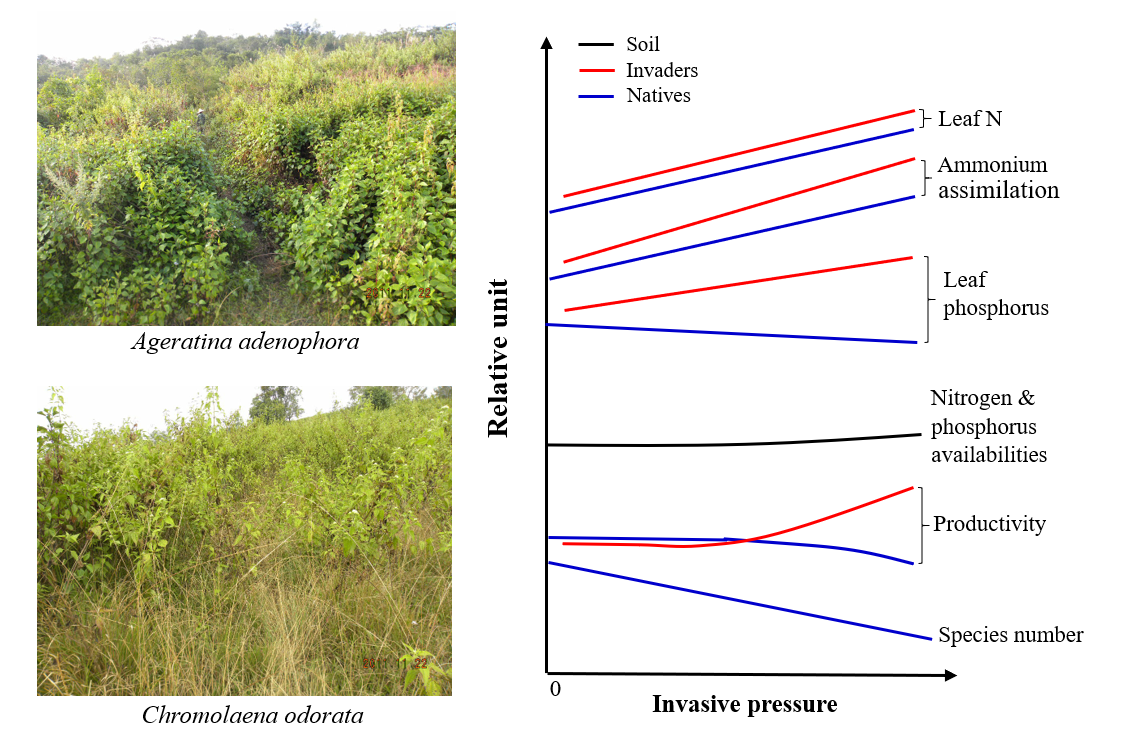Exotic plant invasion is an important eco-environmental problem under global changes, causing irreversible declines of plant biodiversity and negative influences on ecological security and economic development. Since entering the Anthropocene, both the number and speed of exotic plant invasion has dramatically increased by human disturbances. Due to the invasion of more than 200 exotic plant species, China has an economic loss over hundreds of billions RMB annually. The Chromolaena odorata and Ageratina adenophora are native herbs in Mexico and noxious invaders in Asia, Oceania, Africa, Europe, and the USA. In the 1940s, they invaded into the mainland of China from Xishuangbanna of Yunnan province and have constituted a severe ecological problem since the 1950s.
To control exotic plant invasion and reduce its negative effects, it is important to understand mechanisms of their invasions and natives’ disappearance/coexistence. So far, environmental ecologists and plant biologists have conducted studies from plant-soil feedbacks, resource competition, nutrients allocation, exudation allelopathy, and seed bank. Nitrogen (N) and phosphorus (P) are the most common limiting nutrients for terrestrial plant growth. Strategies of N and P utilizations are important mechanisms behind plant invasions and natives’ disappearance/coexistence. Using natural stable isotopes to study in-situ plant nutrient utilization in invaded ecosystems is a novel direction in biogeochemistry.
Supported by projects of National Natural Science Foundation of China (41473081, 41522301, 31570598), Professor Liu Xueyan group in the Institute of Surface-Earth System Science, Tianjin University and collaborators in Chinese Academy of Sciences revealed reveals the mechanisms of N and P utilization of invasive plants and co-occurring plants in Southwestern China. They found that abilities of invasive plants to uptake N and P were higher than those of native plants, and increased with the invasive pressure. Ammonium (the dominant inorganic N source) preference over nitrate is a major cause of higher N-uptake abilities in invaders. For co-occurring plants, leaf N concentrations showed that N availability also increased under invasion, leaf P concentrations decreased under invasion. These results indicated invasion-intensified P competition and lowered P availability for native plants, which is a key reason for distinct decreases of native species with the invasion pressure.
This work enriches the application of isotopic methods in surface-earth N cycling and biological mechanisms. It provides new mechanisms behind plant invasion and coexistence that is useful for better evaluating and predicting exotic invasion and ecological effects. This study was titled “Plant nitrogen and phosphorus utilization under invasive pressure in a montane ecosystem of tropical China” and published online in May 17, 2018. Article information (https://besjournals.onlinelibrary.wiley.com/doi/abs/10.1111/1365-2745.13008):
Chao-Chen Hu; Yan-Bao Lei; Yun-Hong Tan; Xin-Chao Sun; Hao Xu; Cong-Qiang Liu; Xue-Yan Liu*,2018, Plant nitrogen and phosphorus utilization under invasive pressure in a montane ecosystem of tropical China,Journal of Ecology,DOI: 10.1111/1365-2745.13008.

Figure: Variations of soil N and P availabilities, above-ground productivity, species number, plant N and P utilization with the invasive pressure under Ageratina adenophora and Chromolaena odorata in Xishuangbanna of southwestern China.